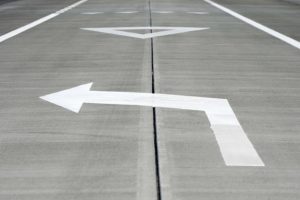Outline
- All the Variables in a Car Crash
- Driver Behavior as part of the Chain of Events
- The Energy Release Theory and Car Crashes
- The Multiple Causation Theory behind Car Crashes
- Near-Crash Hot Spot Examples: A T-Intersection and a Left Turn
- From Theories to Symptomatic Driving Behavior: Identifying Near-Crash Hot Spots using Driving Data
The Safe System approach is centered around the idea that multiple variables can be part of the situations that lead to repeated near-crashes, and therefore car crashes. Tackling near-crash hot spots is therefore a decisive step forward in proactive road safety. But first, it is necessary to identify what causes near-collisions, and where they are located. Looking at them from different angles can help, such as those found in scientific literature: the chain of events, energy release on the road, overall road management… Shared by all near-hits there is nonetheless one common metric: driver behavior. It illustrates how a driver reacts to a given situation. And driving data can unravel driver behavior.

All the Variables in a Car Crash
Near-crashes are a result of the same driver behavior as car crashes – harsh braking, harsh acceleration, swerving… – but don’t result in the same outcome. Identifying and analyzing near misses can therefore provide a wealth of insights into how to proactively make roads safer.
Driver Behavior as a Symptom of a Car Crash
Actor, action, road conditions, road design, multimodal transportation, rural, urban… So many variables come into play and influence each other when trying to understand why a car crash occurs.
Driver behavior connects these different factors together. It is a symptom of a given situation. It is the reason the car crash hot spot can be identified. And it is also only by asking why a specific driver behavior is repeated and at what intensity that the root cause of a car crash can be found. By addressing the root cause, future crashes are prevented. And therefore also potential crashes – leading to safer roads for all users.
Let’s look at some of the factors that can be analyzed to try and identify why a car crash occurs.
Driver Behavior as part of the Chain of Events
The idea here is that car crashes don’t come out of nowhere. There are specific elements that line up like dominos, and if one goes wrong, it knocks over the others, leading to injury. For a car crash hot spot analysis, the elements a road expert can study are:
- the environment
- the driver
- the action taken by the driver
- the crash itself
- the resulting injury.
According to the theory, if one of these elements is removed, the chain of events is disrupted and the car crash is avoided.
Driving behavior is cited explicitly as one of the “dominos” to study, and is a crucial link in the chain of events. It is the action taken by the driver when they find themselves in a given situation. Studying repeated occurrences of a driving action at a given location can lead to analysis of the root cause of a safety problem on the road.

The Energy Release Theory and Car Crashes
This theory studies the rate at which energy is released and what kind of injuries can be sustained as a result, as well as their severity. Higher energy release can result in greater injury.
There are two main methods to prevent stored energy (in this case speed) from building up in an uncontrolled way.
- The first is to reduce the amount of energy needed in the first place.
- The second is to install control methods that work across space and time, and that change the rate of release.
Road safety measures therefore need to contain the amount of energy that is built up and to reduce the amount that is released. Examples of such methods would include any speed regulation assets such as stop signs, traffic lights, narrow streets, roundabouts, speed limits… A wide variety of measures so that speed doesn’t build too much, and potential car crash hot spots can be avoided. Analyzing driver behavior can therefore provide an indication of how effective the measures are at controlling the rate of release of energy.
The Multiple Causation Theory behind Car Crashes
Another theory looks at how multiple factors come together in a random way and meet at a given location and at a given time, producing a car collision.
In the Multiple Causation theory, studying each of the four M’s can show how it impacted the situation:
- HuMan – decisions made or not made, behavior…
- Media – the environment, how do the surroundings factor in
- Machine – vehicles, trams, buses, bikes, etc., what condition are they in, how are they being used…
- Management – what decisions, actions, plans, processes have been made by authorities about a given location
All of these factors and their various combinations create the catalyst behind repeated crashes in a given location at a given time. Again, driver behavior is the constant and measurable variable across all factors that can provide information about what caused a car crash.
Near-Crash Hot Spot Examples: A T-Intersection and a Left Turn

Having looked at some of the theories that try to explain how car crashes occur and help in car crash hot spot identification, let’s transpose them onto two examples of near-crashes. We can see how driving behavior provides the facts that help identify when a near-hit has occurred.
A T-intersection on the Outskirts of the City
Away from busy roads, this quieter location does not seem to present a near-crash risk. The intersection is uncontrolled. Trees are at the right. Vehicle One arrives from the stem of the T and starts to turn left, and Vehicle Two arrives from the right. They surprise each other. The studies a road expert could apply might look like this:
- Chain of events: quieter road => faster driving => trees block the view => drivers can’t see each other
- Energy release: the driver coming from the right builds energy by gaining speed, no impediments in their path. Likewise, the driver coming from the stem can’t see the other driver, and swings into their left turn.
- Multiple causation: edge of town, not much traffic, uncontrolled intersection, poor visibility, late night driving, possible drinking or fatigue…
The driver behavior in this situation? Sudden and atypical swerving, accelerating harshly, braking harshly. Neither driver is expecting the other. They surprise each other, and must react to the situation to avoid a car crash. Not only the two drivers in the example, but repeated sequences of the same activity from other drivers. Aggregating the driving data shows that this is a location where near-crashes occur.
Left turn at a Busy Intersection

In a city center, a dedicated left-turn lane has an advance signal that coincides with the pedestrian signal. As vehicles turn, they don’t always see pedestrians crossing in their marked crosswalk. According to a recent Insurance Institute for Highway Safety study, pickup trucks and SUVs are more likely to hit pedestrians when making left turns. The road expert’s studies in this case could resemble this:
- Chain of events: the light changes => a phone call arrives => the driver looks to the right to see who is calling, away from the direction of travel
- Energy release: pickup trucks and SUVs have high, rectangularly-shaped front ends that don’t absorb impact or let pedestrians roll off
- Multiple causation: the pedestrian and left-turn lights change at the same time instead of giving pedestrians a head start, pedestrians think they are safe as they’re crossing with the light, the windshield “A-pillar” support in some vehicles blocks drivers’ view at exactly that angle.
The driver behavior in this situation? Harsh braking, sudden and atypical swerving. The driver fails to see the pedestrians until the last seconds. If drivers react this way over and over again at this particular intersection, as driving data can show, then it, too, becomes a near-crash hot spot where new road safety measures can be introduced.
From Theories to Symptomatic Driving Behavior: Identifying Near-Crash Hot Spots using Driving Data
To summarize, the chain of events, energy release and multivariable causes are all perspectives from which to analyze crashes – and near-crashes. They are a selection of the theories that can be used to develop proactive road safety solutions. The solutions stem in part from the facts provided by driving data.
Sudden and atypical driving behavior is the symptom of a problem on the road. Driving data locates where near-collisions occur. Further analysis is what will determine the root cause for the driver reaction. And addressing the root cause is how to reliably ensure proactive road safety.
MICHELIN DDi, Your Partner for Proactive Road Safety
Using the driving data provided by MICHELIN DDi, your road safety becomes proactive. Combining our expertise in data analysis and driving behavior, we create solutions that help you detect, locate and assess where near-crashes are happening in your road system.
Our driving data collects driving events. A driving event is when there is a sudden or atypical change in driving behavior – when there is harsh braking or acceleration, speeding, phone handling or a suspected collision. We then aggregate and contextualize driving events. Compatible with GIS systems, they read like a heat map, indicating where events cluster, how often and under what conditions.
Driving events act as your key performance indicators. They help you assess and prioritize road safety measures to address risky road zones – before car crashes happen. After implementing changes, driving data KPIs again show the impact of the changes made.
Partner with MICHELIN DDI to accelerate your road safety strategy. Reach your Vision Zero goals with our mobility insights.

